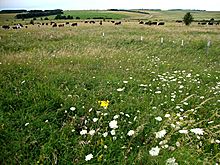|
|
|
|
Comesdeane Well Long BarrowLong Barrow
|
||||||||||||||||||||||||
|
|
|
Images (click to view fullsize) |
|



|
Fieldnotes |
|
|
Although this long barrow is close to a main road, I would recommend that you park in the MOD assembly area (SU 20442 52494) The barrow is quite easy to find and sits next to the only fenced off piece of improved pasture on that part of the training area. I was probably the only person those bullocks had seen all week. With most of the barrows or earthworks on this part of Salisbury Plain, a visit in the winter when the vegetation has died back, giving a clearer shape to the sites' features, is always going to better. This is not really what I would call a long barrow. It does not have much of a presence in the landscape and looks like it was put together in a hurry, without much thought to any alignment or positioning. It does not say anything about laying claim to a piece of land or territory. It makes me wonder if it was even built by the "Long Barrow People" at all. The nearby henge would indicate a sizable community of people living or carrying out ritual in the area. We can only speculate as to what was going on during the late Neolithic but the "Long Barrow People" may have been killed off as a separate race, by people coming in from other parts of Europe. Whether these people came with peaceful intentions or not, they could easily have introduced infections that the native population had never encountered and had no immunity against. This situation occurred time and time again wherever the European explorers came into contact with natives. |
 Posted by Chance
Posted by Chance25th September 2012ce |
Miscellaneous |
|
|
Details of Long Barrow on Pastscape A long barrow, (Grinsell's Fittleton 5), excavated by Cunnington who located inhumations beneath a pile of flints at the NNE end. (SU 19885166) Long Barrow (LB). (1) Fittleton 5. Long barrow; 140 x 55 x 4 1/2 ft. NNE/SSW. Side ditches clear. Excavated W Cunnington: primary deposit of many disordered skeletons beneath heap of flints at NNE end. Skull in Camb Anat Museum. (2) SU 19895166. The long barrow is as described by Grinsell, although only traces of the side ditches remain. Published Survey 25" revised. (3) Originally recorded as Fittleton 5 by Goddard. (4) This long barrow was surveyed at 1:500 by RCHME field staff as part of the SPTA Project (see project archive of further details). Oriented ENE, the mound is 45m long and 17m wide at the E end, tapering to 9m. It attains a maximum height of 1.5m at the E end. The two extant flanking ditches, measure a maximum 42m long and 13m wide and survive to a depth of 0.5m. That to the S being wider, perhaps because of weathering. The barrow is surrounded by a `celtic' field system, overlain by ridge and furrow, but except perhaps for the ditches the barrow itself does not appear to have been affected.(5) -------------------------------------------------------------------------------- SOURCE TEXT -------------------------------------------------------------------------------- ( 1) Ordnance Survey Map (Scale / Date) OS 6" Prov ( 2a) General reference Wilt Archaeol. Natur. Hist. Mag. 38, 1913-14, 409 (M.E Cunnington) ( 2) General reference VCH Wilts 1 1957 140 (L.V Grinsell) ( 3) Field Investigators Comments F1 MHB 20-MAR-73 ( 4) General reference Wilts. Archaeol. Natur. Hist. Mag. 38. 1913-14. 256. (E.H Goddard) ( 5) General reference D Field/2-2-95/RCHME:SPTA Project |
 Posted by Chance
Posted by Chance27th July 2012ce |

